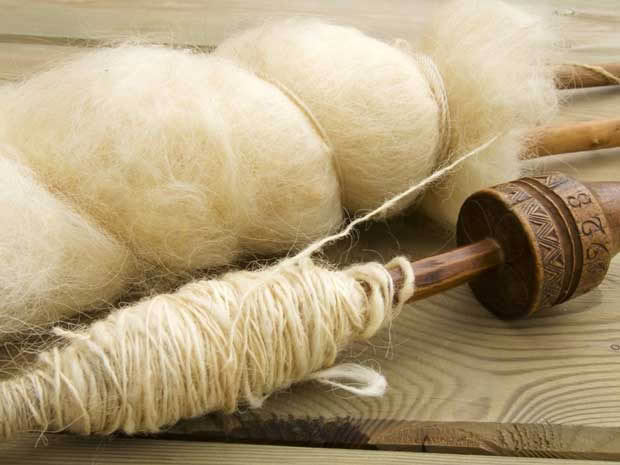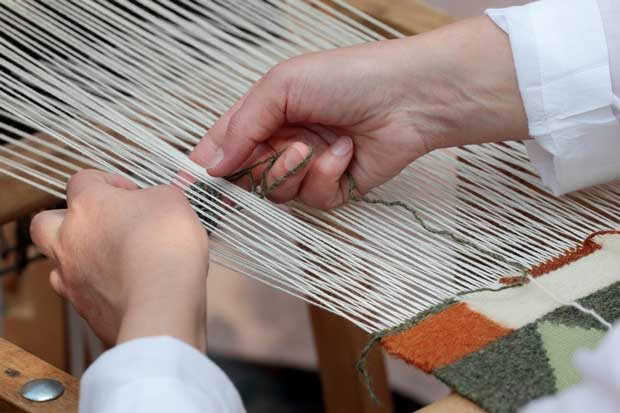How to spin wool and weave

Creating your own curtains, clothing and other fabrics from your own livestock is another great skill set for the self-sufficient.
Words: Nadene Hall
10 THINGS YOU NEED TO KNOW ABOUT SPINNING WOOL
1. IT’S EASY TO HAVE A GO
If you’ve always been interested in spinning wool from your own sheep or fibre from your goats, alpaca or llama, or want to weave, knit or felt with it but have no idea where to start, contact your local Creative Fibre group. There are 15 areas throughout New Zealand and all have groups of expert spinners and fibre artists who are willing to help you learn the process.
Most groups allow new possible members to attend three meetings before any subscription is expected. The subscription then allows lots of information to be sourced along with the national Creative Fibre magazine for a year.
Groups also hold workshops for beginners and take them through the whole process, and onto more complex work and other skills such as dyeing.
www.creativefibre.org.nz
2. YOU DON’T NEED LOTS OF FANCY GEAR
Top New Zealand weavers Nynke Piebenga and Jean Welch do have their own full-size looms and other weaving and spinning gear, but you don’t need to invest in anything like that if you can’t afford it.
“When you do a workshop, we use table looms which are much smaller and they fit into the boot of your car,” says Nynke, who runs workshops for everyone from beginners up. If you don’t have room for a loom, spinning wheel or other equipment, most groups have communal gear that can be used on a regular basis.
“We have a few weavers who come to workshops because they love doing it but they don’t have time at home, so they just come for a weekend of weaving. People do it for different reasons, some really need to be creative, some like the company as much as anything else.”
3. IT’S AN ART…
There is a technical side to weaving with tools, skill sets and processes, but for both Nynke and Jean, their favourite part is the creativity they get to unleash.
“I love the mathematical side of it and that’s mostly part of the planning,” says Nynke. “I love the creative side, the texture is sometimes strongly emphasised and other times it’s the colour.
“I was doing something yesterday… it was a bit dull, not exciting really, so I went up to my yarn stash, laid some colours out over the weaving I had done, and you can do that while the process is on the go. It just needed a bit more ‘oomph’, something to make it a bit more exciting.”
4. … AND IT’S ALSO OBJECTS
There is a practical side to all the creativity says Nynke. “When I would go away (on Creative Fibre business) and stay a night, I would be billeted and instead of a bottle of wine, I would give (the hosts) a woven hand towel.”
5. IT’S EASY TO LEARN THE BASICS
Jean has taken courses run by Nynke, and Nynke says teaching is her way of giving back to a craft that has given her so much.
“I take beginners slowly step by step through the process of winding the yarn in preparation to get the ‘warp’ onto the loom, then they are usually weaving by the end of the first day.
“The second day – it’s usually a weekend class – we weave a bit more, then go through the process of how they get it off the loom, and see if they have questions, talk about different yarns and fibres and what to look out for, how to plan a project. If someone wants to make cushion covers where do they go, where do they start? We work it out on paper so they can go home and are able to plan something themselves.
“A certain percentage will go home and they’ll be really keen and you usually see that in their first weekend. Some just want to get an idea of what it’s all about and decide it’s not really for them, or they just like to do it themselves.”
6. COLOUR YOUR WORLD
Nynke created the fabrics for her home that were used for curtains and upholstery using wool and cotton.
“You can dye cotton but it’s easier to dye wool and dye it to the colour you want which is an advantage, and wool is definitely more readily available in New Zealand too.”
7. IT’S A BIT ADDICTIVE
Everyone who is creative has a ‘stash’, yarns or fibre or whatever their particular passion is, squirreled away in storage, ready for use in an as-yet unrealised project.
“You don’t want to see mine, we can’t help ourselves,” laughs Nynke. “I got a newsletter from a local group and a lady I know was selling a few beautiful yarns. I had not even seen it but I trust her, and bought it over the phone!
“I store mine in plastic boxes and I stack them on top of each other and they go right around the wall… it doesn’t look so bad!”
8. YOU’RE ALWAYS LEARNING
Jean Welch has been creating award-winning textiles for a few years now but she still enjoys attending classes run by Nynke, while Nynke loves to learn from weavers even more experienced than her such as Agnes Hauptli.
“Weavers always want to learn more,” says Nynke. “Other people always pick up little gaps in their knowledge.”
For Nynke currently, that’s trying to figure out why a certain mix of silk yarns in a recent piece she has woven turned out to be a spectacular iridescent fabric when it was finished.
“I used two different colours that were quite closely related. I used a blue and a red that are about the same value of colour – that’s the depth of colour when you put them on a grey scale. I have a grey scale from white to black with 12 tones of grey. To see the ‘value’ you half close your eyes, take the thread and you move it onto that scale and in one area you’ll see it ‘fall’ away (disappear) – that’s its value. If you do the other colour and it’s the same ‘value’ that’s when I think it (the iridescence) happens.
“It’s definitely magic when it comes off, and it’s so nice! It was just what I wanted to happen but I didn’t know it had until it came off (the loom) – when it’s tight on the loom you can’t see it.”
9. YOU CAN MAKE MONEY IF YOU KNOW WHAT YOU’RE DOING
Both Jean and Nynke weave because they love it, but there are craftspeople who make money from their art.
“If you want to earn money with it, you should really specialise in one thing and keep at it,” says Nynke. “You can create a market doing that, but that has never been me – I love the very fine work but then when I finish I might want to do something quicker and weaving gives me all of those opportunities.
“You really have to be able to sell – there’s only so much you can give away – because you’re competing with the Chinese stuff that comes in at a quarter
of the price.”
10. IT’S FUN
When Nynke is weaving, she spends her time creating and also learning about the world.
“Once you’ve done all your planning, and if the weaving is easy, I have the radio on. I listen to nice music or the National programme interviews. I’ve got two radios – one on either side of the loom – because our radio reception is really poor and they need to be carefully fine-tuned.
“For myself, I can’t say there’s one aspect of it I love more than the other – I like to sit and do it all and have the variety and I’m fortunate that I can at this stage of my life.
“I don’t have to earn a living with it – I can enjoy my passion.”
WEAVING IN FIVE EASY STEPS

1. CHOOSE YOUR WOOL OR FIBRE
When she’s weaving with mohair, a very light fibre with excellent insulation properties, Cambridge weaving expert Jean Welch mixes it with other wools – usually from her beloved Perendales – to get the best out of both fibres. Mohair on its own tends to be ‘sticky’ and is difficult to weave but mixing it with wool helps to keep the finished piece even.
2. CREATE YOUR PATTERN
Jean likes to be able to look down on a project like a rug or a shawl, laying out yarns in a pattern to see what colour combinations work best. Different weavers use different processes depending on their preference.
3. THREADING THE LOOM
For a large piece with a complex pattern, it can take a couple of days to thread the yarn onto the loom.
“I enjoy the threading up more,” says Jean. “It’s the challenge of not making a mistake. If you do you’ve got to find it and fix it and sometimes you don’t see it until you’re weaving so you’re always double-checking to make sure the pattern hasn’t gone wrong.”
4. WEAVING
Looms can be small enough that they fit on your kitchen table and store under your bed, or they can take up a whole room. While all follow the same process, some use different methods to get there.
5. AFTER WEAVING.
Once the weaving process is over, the newly-created fabric is removed from the loom and the ends are knotted or fringed to stop them unravelling, and the piece is washed to finish it.
“The yarn shrinks and matts up together, it closes up,” explains Jean. “I wash mine by hand, then I put them in the washing machine and spin on the wool cycle to get the moisture out, then roll them up in an old sheet and leave them to dry like that overnight.”
While many pieces won’t be perfectly dry the next morning, they can then be unrolled and laid out on a floor, table or bed to finish drying, the fringes are tidied and any mistakes are fixed.

